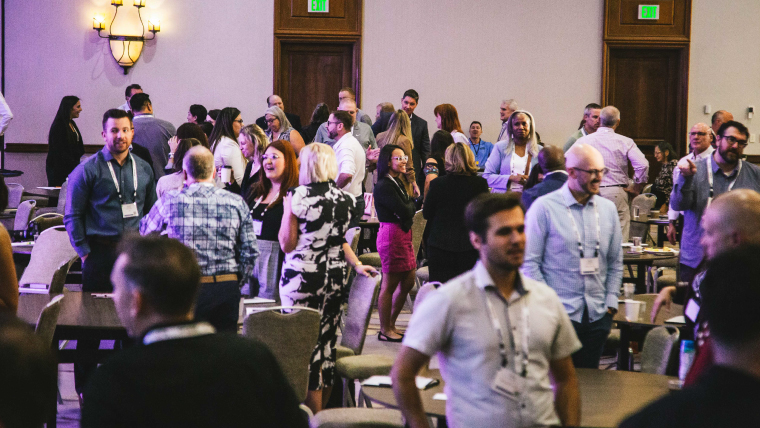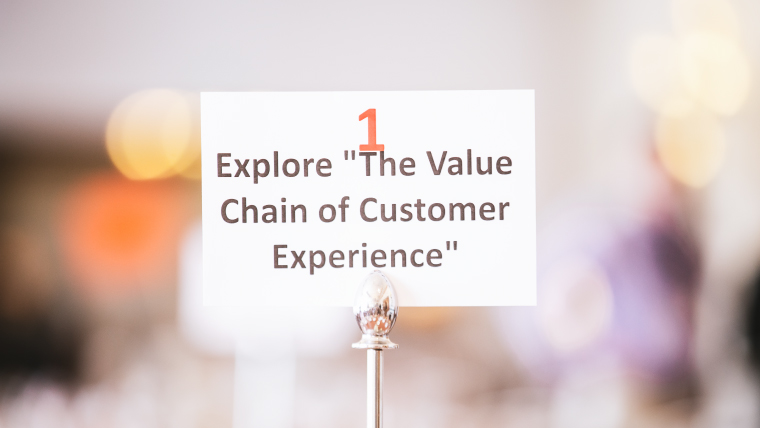Introduction
Newsflash! This year’s 20th Anniversary Annual Contact West: A Frost & Sullivan Executive MindXchange, was recently held at the JW Marriott Starr Pass in Tucson. It was a unique meeting of innovative, enthusiastic and collaborative minds.
The event consisted of inspiring keynotes, breakout sessions, interactive panels, the ‘solutions wheel’ and casual hallway discussions – all taking place under one roof. Each participant and solution partner offered a plethora of perspectives, commentary and information, freely shared. This insight paper provides highlights and essential takeaways from a select number of sessions held during the event.
Predictions: Navigating A Bold, Boundless…and Bumpy Future!
In her keynote address, Christina “CK” Kerley, talked about an “Era of Mind-Blowing Progress at Jaw-Dropping Speed and Scale.” She outlined a compelling look at a CX fast-forward future that promises to be:
- Automated
- Skills-led
- Accelerated
- Demanding
- Messy
CK maintains that acceleration isn’t really the issue at hand. She points out that it‘s the lack of preparation that is the real culprit.
The author and futurist warned CX leaders in the audience to not focus on the shiny new AI tools, but rather on what solutions can do to improve, enhance and solve problems for customers. She believes that the skillset of the future will be made of emotional intelligence, adaptability, collaboration and critical thinking. CK concluded by noting that while our CX future promises to be fraught with disruption, there is a tremendous opportunity window in chaotic times.
Key Take-away:
The future – while uncertain, accelerated, and messy – offers great opportunities for business and professional growth if we Re-alize, Re-structure and Re-prioritize.
Prioritizing Objectives and Modernizing Your Technology
Susan Weaver, Chief Customer Officer at Slavic401k presented her views on the importance of:
- Defining and Aligning Objectives
- Prioritizing Projects
- Conducting a Cost-Benefit Analysis
- Implementing Data-Driven Decision Making
Susan’s advice is that new technology investment must be tempered with:
- Assessing current technology in-place
- Examining trends in tech modernization
- Fostering a customer-centric environment
- Selecting the right mix of artificial intelligence (AI) and machine learning (ML) technologies
Key Take-away:
Prioritizing the right projects with data-driven decision making will offer better chances of success and yield greater benefits when seeking new, modern technology investments.

Come Together and Take a Holistic, Agile Approach To Customer Experience
Scott Campbell, Chief Client Experience Officer at American National, is an expert on agility and business strategies. Scott has over 20 years of experience in marketing, communications, and brand management, spanning multiple product lines and distribution channels in the insurance industry. He shared valuable insight on the importance of building fast and seamless client interactions through digital platforms. He noted how leaner, high-quality internal teams can better focus on handling high-complexity, high-touch calls.
Key Take-aways:
- Consolidate contact center/self-service platform strategies
- Establish a unified set of KPIs to align teams around common goals and success metrics
- Pursue Agile development to increase speed to market and drive results
Culture by Design
Do you ever wonder what employee engagement really entails? Kevin Gober, MBA, Senior Director, Arena Talent Experience, Miami Heat, shared his definition with Customer Contact West participants in this way:
Employee Engagement: The extent to which employees feel passionate about their roles, are committed to the team/organization and put discretionary effort into their work {into winning}.
Kevin believes that organizational culture must be clearly defined and cemented into the hearts and minds of every team member. In this way companies can retain top-tier talent, maintain productivity and drive revenue and growth, Kevin says, “Our culture is our true north. Tells us what to do, how to do it, and how to recover. In sports, it’s about championships – that is, a culture of winning.”
“Employee engagement is not what we {leaders} say it is, it’s what they {our people} say it is.”
-Kevin Gober
Key Take-Aways
Make employees feel valued by supporting their thoughts, ideas and efforts – while being fair and consistent. Involve employees in the development of new processes and celebrate the outcomes with them. Learning from mistakes develops and encourages employee growth and demonstrates concern for everyone’s mental health.
Panel Perspectives: Ask the Experts
Do This, Not That: How We’re Using AI and How It’s Working Out
The thought leaders listed below graciously served as panelists to share their company’s unique use cases and the key stages of their AI journey—from initial planning and deployment to ongoing optimization. They shared effective strategies, the pitfalls to avoid, and how AI is transforming operations in real-world scenarios.
Moderator: Cippy Seidler, Director, Consumer Care Center, Banner Health
Panelists: Heather Arthur, Vice President, Canada Contact Centres, Scotiabank
Jeff Grant, Senior Technology Consultant, Enterprise Contact Center, Southwest Airlines
Andy Lisk, Vice President, Global Head of Customer Service, StockX
A sampling of panelist comments:
“We just started to use conversational AI this week. We needed to have consistent answers for customers and have agents available to work on more complex issues.”
“We are 2 years into a 5-year plan. There is a lot of work to do to clean up documentation and policies to make them simple for chatbots and agents to use.”
“Give the tech to agents first. Then get immediate feedback. When agents talk to others about the benefits AI, that builds enthusiasm for the process.”
“Get the budget approved. Start today. Train agents to be digital adopters; to learn, process, and master AI automation tools.”
“So far, the response from customers has been positive – at least for simple issues. We are finding that we have to keep training AI, as processes and procedures change.”
Key Take-aways:
- The data and its source are very, very important. Ensure that the data is clean and uncorrupted
- Get front-line agents involved in the development and implementation of AI solutions early on. This will drive engagement, adoption and advocacy for the use of AI technology.
- Invest in continual AI coaching and training to help employees work better, faster, and with more confidence
- Where to start with AI? Email is great place to begin. Then progressively, apply it to repetitive, mundane tasks

THE FIX – Crowdsourcing Tactical Solutions to Our Most Vexing Challenges
Is Remote Work the New Normal?
Among the most popular, yet challenging sessions was “THE FIX.” It consisted of four themed brainstorming sessions designed to uncover solutions to some of the most common operational issues that contact centers and their leaders face today.
Here are just a few of the ideas generated during these rapid-fire 15- minute sessions:
During The Fix on Adapting to Remote as the Norm, led by Chad Anderson, Vendor Manager of Customer Care Operations Mercedes-Benz USA, participants identified these top 10 challenges when working remotely:
- Maintaining high productivity
- Agent morale and future lack of engagement
- Training and acculturation
- Remote performance management competence and trust
- Work-life balance for agents and managers
- Ways to make a better human connection among team
- “Mastering the game.” Employees look like they are working, but they are not.
- Lack of collaborative problem-solving opportunities
- Supervision: Coaching element gets more difficult
- Communicating a central message to everyone that is understood and acknowledged
Participant commentary and ideas to build morale and engagement among remote agents included:
“We conduct virtual company-wide activities, such as Jeopardy, we laugh, we do yoga. It’s about creating connections in a way that isn’t a formal meeting.”
“Our team meets for a “Happy Hour” virtual event where we pick a topic, and we share about ourselves”
“Our business brings agents(both remote and in-person) into the office for appreciation gifts. In some cases, we pay to fly them in.”
“While it’s a challenge to see how agents are feeling, we like to check in once an hour to capture sentiment, and then post a reply to that agent. In some cases, it makes sense to allow people time off the phone for a bit.”
“We’ve created a break room with Microsoft Teams where employees can chill out, listen to music, have an ad-hoc conversation or even send emojis.”
“At our center we celebrate customer service week, involving pictures, team activities, and points & rewards – all of this with people rotating in and out of the office.”
Key Take-aways:
- There are many challenges with a remote workforce. Companies can meet those challenges head-on by promoting an inclusive company culture, providing more human interactions like mentoring and intentional collaboration
- Focus on reassuring agents when discussing AI. Getting their buy-in is a major challenge. It’s critical to ensure that employees understand the complexity, benefits and value.
- Communication with remote employees can be improved by documenting processes and creating benchmarks. Introduce changes in small digestible units versuswholesale change management
- Consider having regular, virtual “town halls” to drive consistent communication and transparency
Analyst Corner: The Last Word
In the current era of unbelievably rapid technological change, digitization and the promises of AI are fundamentally altering how businesses go about caring for customers. A massive acceleration of consumers adopting artificial intelligence and digital channels in the last two years has put pressure on customer operations to support increasingly demanding consumers.
Among the many challenges discussed by participants, contact center practitioners and thought leaders at the event reported the following:
- Striking the right balance between CX technology (AI, CCaaS, LLM,NLU, bots, automation)and live agents
- Finding ways to re-engineer contact center culture and agent engagement
- How to better utilize workforce management solutions for agent recruiting, hiring, training and attrition reduction
- Creating future strategies to improve employee engagement and retention
- Understanding the complexity in contact center AI security and compliance
- Examining how to combine empathy and technology to drive higher levels of customer and employee satisfaction
The unprecedented speed of change presents significant personal and professional challenges for many of us. Those who seize this opportunity to thoroughly and holistically reformulate the customer experience will achieve a significant competitive advantage. As a result, many organizations today view the customer experience differently. Countless companies look to transform only the operational side of the business. Frost & Sullivan believes that it is now time to transform an entire industry mindset using an end-to-end view to thrive in a volatile, ever-changing business environment.
Michael DeSalles has extensive experience covering a broad range of sectors, leveraging long-standing working relationships with leading industry participants and senior executives in the CX industry. His areas of focus include customer care outsourcing, skills-based routing, BPO nearshore deployment, home-based agents and contact center security.
Frost & Sullivan, a leader in Growth, Innovation and Leadership for over 60 years, has rigorously tracked the CX industry for the last decade.



